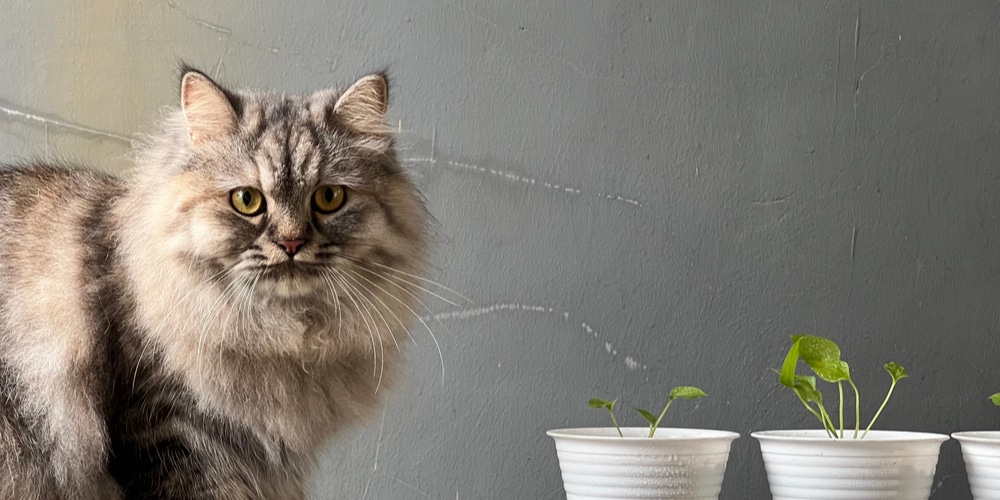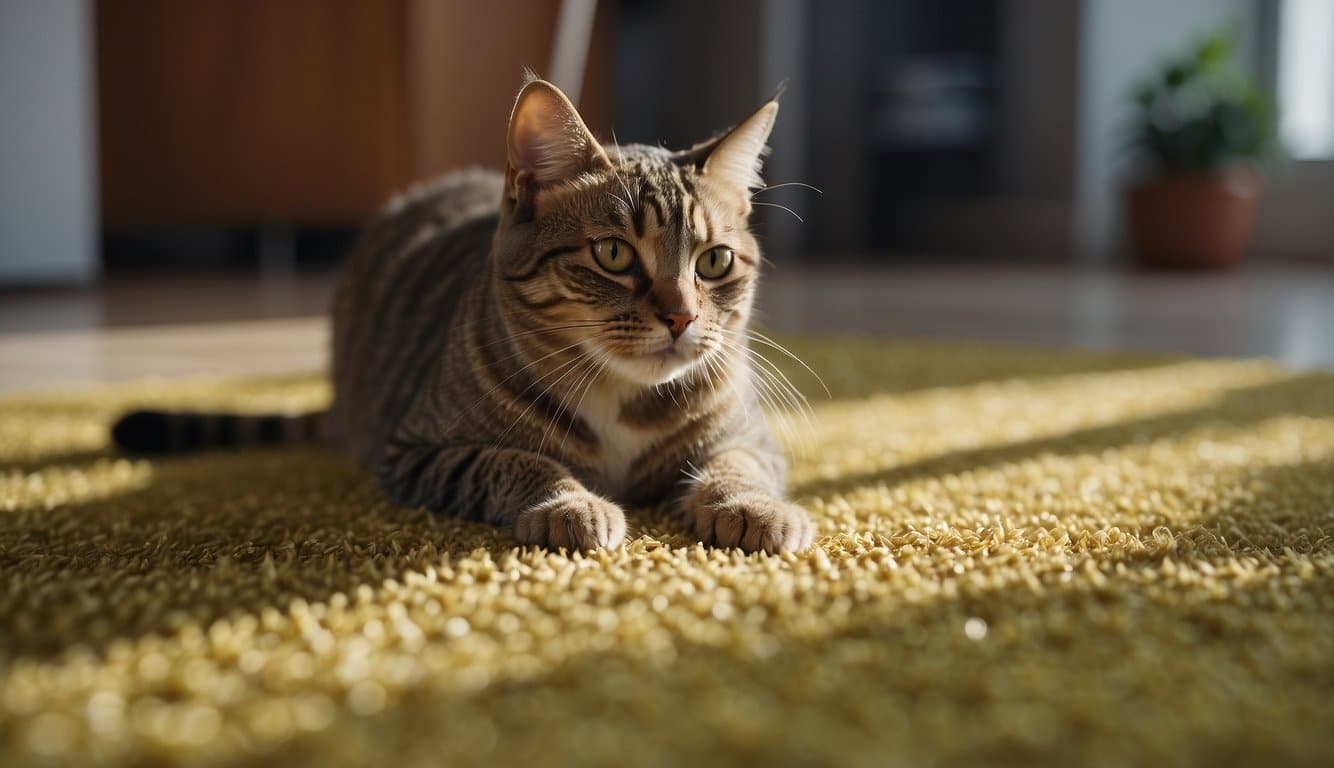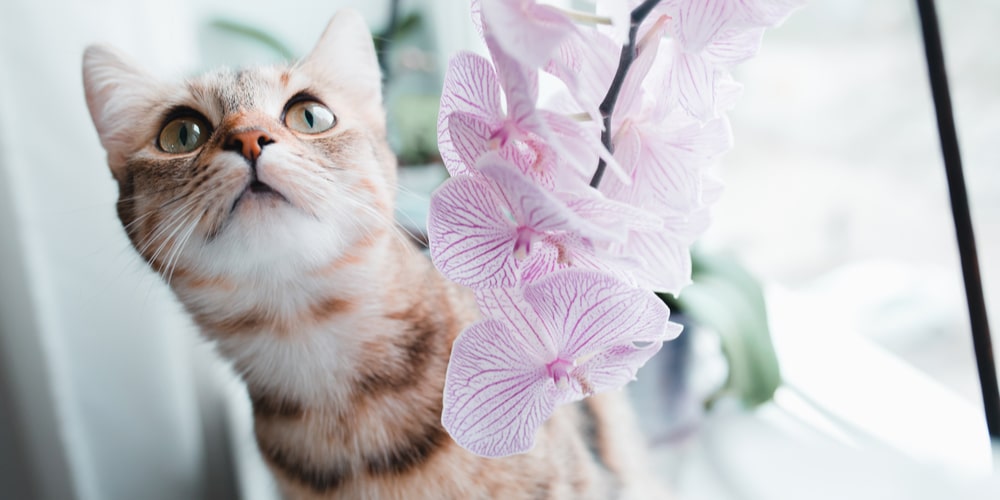Getting Rid of Cat Pee Smell: A Winning Plan

Step 1: Locate the Source
- Question: Have you identified where the cat pee is?
- Yes: Proceed to Step 2.
- No: Use a UV light to find old stains or sniff out the source.
Step 2: Blot Up Fresh Stains
- Action: If the stain is fresh, blot up as much as possible.
- Method: Use paper towels or a clean cloth to press firmly against the stain. Avoid rubbing to prevent spreading the urine deeper into the fabric or carpet.
Step 3: Apply a Cleaning Solution
- Question: Is the stain on a washable fabric?
- Yes: Wash using an enzyme-based detergent.
- Washing Tips: Use the hottest water safe for the fabric and add a cup of baking soda to the wash.
- No: Use an enzyme cleaner on carpets or upholstery.
- Application: Soak the affected area thoroughly with an enzyme cleaner to break down the urine components.
- Yes: Wash using an enzyme-based detergent.
Step 4: Let It Sit
- Action: Allow the cleaning solution to sit for 10-15 minutes (or as directed by the product).
- Purpose: This allows the enzymes time to break down the ammonia and other components of the urine, which cause the smell.
Step 5: Rinse and Dry
- Action: Rinse the area with clean water (if applicable).
- Drying: Blot dry with towels or use a wet vacuum to remove excess moisture.
Step 6: Check for Remaining Odor
- Question: Can you still smell cat pee after the area has dried?
- Yes: Repeat the cleaning process with the enzyme cleaner.
- No: Move to Step 7.
Step 7: Prevent Future Accidents
- Action: Address the underlying cause of the accident.
- Behavioral Issues: Ensure the litter box is clean and in a quiet area. Consider any stressors or health issues that may be causing inappropriate urination.
- Territorial Issues: If marking is an issue, consult a veterinarian or animal behaviorist for advice.
Step 8: Use Odor Neutralizers
- Action: After the area is clean and dry, use an odor neutralizer.
- Options: You can use commercial products or natural solutions like a vinegar solution (one part water to one part vinegar) or baking soda.
Step 9: Maintain Cleanliness
- Routine Actions:
- Regular Cleaning: Keep the litter box clean and the home environment clean and fresh.
- Monitoring: Regularly check the previously affected area to ensure no re-soiling occurs.
Additional Tips
- Ensure good ventilation during and after cleaning to help remove odors.
- Consider using waterproof seat covers or area rugs that are easier to clean if your cat has frequent accidents.
Winning the Battle Against Cat Pee Odor
Dealing with cat urine smell can be frustrating, but your home doesn’t have to be ruled by odors.
Discover the source and utilize airflow to reclaim the freshness of your space with effectiveness and ease.
Identify the Source of Cat Urine
- Start with a Spot Check: Grab a UV flashlight and systematically scan every corner of your rooms.
- Act Fast: Once you’ve found the spots, clean them promptly.
- Absorbing fresh spots with paper towels and using an enzyme-based cleaner can be particularly effective, as it breaks down the urine and neutralizes the odor.
Natural Ventilation Tactics
- Open Up: Increase airflow by opening windows and doors. A cross-breeze can help whisk away the scent.
- Harness the Sun: Place smaller items that have been soiled in direct sunlight after cleaning. The sun’s UV rays assist in breaking down odors.
- Use Nature’s Fresheners: Consider adding air-purifying plants to your home, and use natural odor absorbers like baking soda on carpets or furniture.
Cleaning Solutions and Techniques
When your kitty leaves a little surprise outside the litter box, don’t despair!
You’ve got this – with the right tools and techniques, you can banish that cat pee smell for good.
Homemade Remedies
- Detergent and Club Soda: Get your hands on some dish detergent and club soda for a DIY fix.
Dilute a few drops of dish soap in water and soak the smelly spot. After letting it sit, help yourself to a club soda rinse for a fizzy, odor-busting finish.
- Vinegar and Water: Mix equal parts white vinegar and water in a spray bottle.
Give the urine-stained area a liberal spritz, and then use the might of your muscles to work it in with a brush. This homemade mixture can be a lifesaver!
Commercial Enzymatic Cleaners
- Select a Specialty Brand: Look for a cleaner that can break down the stink at a molecular level.
These enzymatic cleaners are the real deal, and they don’t just mask the odor – they eliminate it.
- Follow the Instructions: Remember to read the label and use as directed.
Often, you’ll need to let the cleaner sit to do its magic. Patience is key, as some products require time to thoroughly neutralize odors.
Preventative Strategies
Before you’re faced with the stink of cat urine, take action with strategies that discourage your feline from turning your home into their personal lavatory.
Here’s how to keep your spaces smelling fresh and clean.
Training Your Cat
- Begin with a litter box for each cat plus one extra; this reduces competition and provides ample opportunities for your cats to relieve themselves properly.
- Consistency is key in litter box training; place your cat in the litter box after meals and naps to encourage good habits.
- If accidents occur, clean them up immediately; lingering scents can signal to your cat that it’s okay to go there again.
Making the Home Unwelcoming to Urine
- Use cat repellent sprays in areas where your cat has shown interest in marking; these sprays have scents that cats dislike.
- Strategically place aluminum foil or upside-down carpet protectors in off-limits areas; cats dislike the feel of these textures under their paws.
- Ensure that your home is stress-free for your cat, as stress can contribute to inappropriate urination; incorporate plenty of play and attention into your cat’s routine.
Materials and Surfaces
When it comes to eliminating cat pee smell, the type of material and surface you’re dealing with can make a big difference in your approach.
Your game plan should be tailored to tackle the specific challenges each material presents.
Soft Furnishings
For upholstered items like sofas and curtains:
- Pre-treatment: Blot the spot to remove as much urine as possible. This is your first line of defense.
- Cleaning solutions: Use an enzymatic cleaner, which breaks down the urine at a molecular level. Avoid using hot water as it could set the stain.
Laundry-safe items like throw pillows and blankets:
- Wash alone: Run them through the wash separately to prevent transferring odors.
- Additives: Include a cup of baking soda or a quarter cup of vinegar to boost odor removal.
Hard Floors and Walls
On non-porous surfaces such as tiled floors and walls:
- First step: Remove any debris and blot up the urine.
- Cleaning agent: Mix water with white vinegar – the acidity helps neutralize the urine.
For wooden floors or painted surfaces:
- Gentle cleaning: Avoid harsh chemicals which can damage the finish.
- Specialized products: Consider odor-neutralizing products designed for wood that won’t cause harm.
Long-Term Odor Management
When you’ve got a feline friend leaving behind those not-so-sweet reminders, a strategic plan is what you need for long-term odor control. Here’s a punchy, straightforward guide to keeping your castle smelling fresh:
- Regular Cleaning: Like clockwork!
- Scoop daily, change litter weekly
- Clean accidents immediately with an enzyme cleaner
- Air it Out: Goodbye, stink! Hello, fresh air!
- Open windows, get those fans running
- Consider air purifiers for constant freshness
- Preventive Measures: A savvy move!
- Neutralizing sprays that are safe for pets
- Odor-Resistant Accessories:
- Opt for litter boxes with antimicrobial protection
- Washable mats that catch litter spills
- Identify the Cause:
- Is Fluffy stressed? Health check-ups at the vet can help.
- Spot behavioral patterns, nip those naughty bathroom habits in the bud.
- Odor-Proofing Arsenal:
- Invest in odor removers designed for pets
- Baking soda in litter boxes does wonders!
- Freshness Hacks:
- Plants that purify the air
- Essential oil diffusers (pet safe, of course)
Frequently Asked Questions
Navigating the stinky maze of cat urine odors can be overwhelming. Below, you’ll find the inside scoop on tackling those pesky whiffs with tried-and-tested methods that’ll bring your nose and household peace.
What home remedies conquer old cat urine odors naturally?
- Baking Soda: Sprinkle generously on the affected area, let sit, then vacuum it up to help absorb the smells.
- Vinegar Solution: Mix equal parts water and white vinegar, apply to the area, and blot dry to break down the urine remnants.
What’s the ultimate secret to removing cat pee smell from carpets?
Using an enzymatic cleaner specifically designed for pet odors is your best bet. These cleaners break down the urine at a molecular level, eliminating rather than masking the odor.
Discovering phantom feline fragrances: Strategies for eradication?
First, determine the source by using a UV light to detect old urine spots. Clean these areas meticulously with an enzymatic cleaner or make a mixture of detergent and club soda for a DIY solution.
Fashion vs. Feline: How to restore clothes after a cat-astrophe?
- Wash separately: Rinse the affected clothing in cold water, then wash with a cup of vinegar added to your usual detergent.
- Air dry: Let the clothes air-dry to ensure all odor-causing remnants are gone.
Wood you believe it? Effective methods to neutralize cat pee on timber!
Treating wood surfaces requires a gentle approach to avoid damage:
- Clean the area with a mild detergent and warm water.
- For persistent odors, a mix of vinegar and water can help neutralize the smell without harming the wood.
Playing detective: How to outwit invisible but smelly cat pee reminders?
Track down the scent by:
- Inspect common areas where your cat frequents.
- Clean with a combination of baking soda, hydrogen peroxide, and dish soap for a deep clean that targets hidden odors.
Last update on 2025-04-20 / Affiliate links / Images from Amazon Product Advertising API






